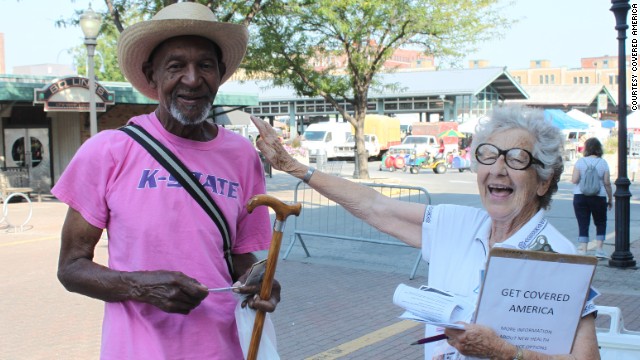It's October 1, ObamaRomneycare Kicks Into High Gear With Enrollment.
Obamacare open enrollment: Here's everything you need to know
STORY HIGHLIGHTS
- 48 million Americans lack health insurance, according to the Census Bureau
- In 2014 every American will have to have some form of health insurance
- If you don't have some form of health insurance next year you will be fined at least $95
It's not her birthday nor her anniversary.
October 1 is the day that marks the first time ever she will be allowed to buy health insurance.
Like more than 48 million
other Americans, the Wisconsin stay-at-home mom does not have insurance
to pay for doctor bills if she gets sick. It's particularly
disconcerting when she thinks about her husband, Chris, who runs a
tree-cutting business. Being an arborist is physically demanding. He has
fallen out of trees.
Oct. 1 -- March 31 open enrollment for health insurance marketplaces.
Dec. 14 -- buy your plan through the exchange by this date if you want it to start by January 1, 2014
Jan. 1, 2014 -- all legal residents and U.S. citizens must have qualifying health coverage
Oct. 15- Dec. 7, 2014 --the next Open Enrollment Period for the marketplaces.
"You know something as
simple as a sprained ankle, none of that is covered right now, none of
it," Braun-Gross said. "To add the cost of that to the debt we already
have, we'd basically be up a creek."
Braun-Gross and her
husband have tried to get insurance before, but they don't qualify. They
both work hard, and they're college educated. But because of some
pre-existing conditions, including Braun-Gross' weight, insurance
companies haven't wanted their business.
Obamacare will change all that. The law forbids insurance companies from rejecting people like Braun-Gross because of their pre-existing conditions. To make that affordable, though, one of the most controversial parts of the Affordable Care Act is about to go into effect.
By 2014 every American, with some very few exceptions, will have to have some form of health insurance or be fined. The idea is that more healthy people will buy insurance, and the money the insurance companies save on them will cover the costs of insuring the older and sicker people who will now be in the insurance system.
 Obamacare: Everything you need to know
Obamacare: Everything you need to know
Employers will provide insurance for three out of every five Americans in 2014, according to the Congressional Budget Office.
Another 12% get it through Medicaid or the Children's Health Insurance
Program. For those Americans and for the Americans covered by Medicare, October 1 won't mean much.
 Foes Go All Out To Undermine Obamacare
Foes Go All Out To Undermine Obamacare
But for people without insurance, October 1 will be the first time they will be able to shop for private insurance in health insurance marketplaces, also known as exchanges. Many will be eligible for government help to pay for those plans.
 Clinton asks Obama about Obamacare
Clinton asks Obama about Obamacare
With so many politicians
fighting over this controversial legislation, the details about how to
sign up may have gotten a little lost. So, here is what Braun-Gross and
the other millions of Americans like her need to know when open
enrollment starts on Tuesday:
The deadline
Open enrollment runs between October 1 and March 31. You don't have to sign up that first day. In fact, you may want to put off paying for it until December. Plans bought through the exchanges won't start until January 1.
December 14 is the
cut-off date if you want your plan to start January 1. Open enrollment
runs through March 31. If you sign up in January or February your
coverage will start the following month.
When Massachusetts
rolled out a similar health insurance mandate in 2007, the biggest spike
in enrollments came in the two months before people would be charged a
penalty for not having coverage, according to Jon Kingsdale
who ran the state's health benefit exchange then. He also noticed many
people came back to the state's website to evaluate the potential plans
more than once.
The experts advise you to take your time. Comparison shop to find the policy that works best for you.
Where to start
If you have Internet access, start with the Web. Beginning October 1, Healthcare.gov will have the information you need. The government site will link to where you sign up for the program.
Go first to "get insurance."
That tab will get you to a page that will walk you through whatever
marketplace is available to you. Some states set up their own; the
federal government runs the rest. On this site you can also compare the
plans available in your area.
You may also want to see if you are eligible for Medicaid here. So far, 26 states
are moving toward expanding who is eligible for the federal
government-funded health program for lower income families and
individuals.
You can also enroll by mail.
The government has set
up call centers to help people with open enrollment. Call 1-800-318-2596
(TTY: 1-855-889-4325). The number is staffed around-the-clock.
Information is available in more than 150 languages.
There will also be specially trained advisers in communities. These "navigators," as they are known, can help you in person. There will also be federally authorized marketplace-designated organizations. They will be based in community health centers, at the mall, in drug stores and in churches.
Depending on state law, traditional agents and insurance brokers can also help.
Unlike brokers or agents, navigators and marketplace-designated organizations
can educate you about the plans, but they cannot tell you which plan to
pick. Their advice is free. If someone who is a navigator or a
federally designated organization tries to charge you, it is a scam.
The health care plans
There are several. The bronze level will be basic, silver midrange, while gold and platinum will be higher-end. There will also be a catastrophic option. Catastrophic insurance covers three doctor visits per year at no cost and preventive care such as screenings and vaccines. This plan will carry a higher deductible.
All plans bought through the exchanges must offer the same coverage benefits. All offer free preventive care. Nearly all cap out-of-pocket costs to $6,350 and $12,700 per family. No one can be turned away. No one will be penalized because of their gender (women often paid more in the old insurance system). Only smokers may be penalized in some plans and some older people may pay more.
The cost
What varies with the plans is cost. Some will carry higher deductibles. Some ask for higher co-pays. Costs will vary based on where you live. If you want to see what your bill may look like, be sure to check out the calculator the Kaiser Family Foundation put together. The nonpartisan foundation's tool provides an estimate of your costs depending on where you live and based on the kind of coverage you pick.
The majority of people uninsured today can find a policy for $100 or less a month, taking into account subsidies and Medicaid eligibility, according to the Obama administration.
No matter what the cost, you will pay a monthly premium, and may also have a co-pay or be asked to meet a deductible when you go to the doctor or hospital.
The good news is if you go through the exchanges rather than buy directly from an insurance company, you will likely be eligible for tax breaks and subsidies to pay for your insurance. The assistance is available to those with incomes of up to four times the federal poverty level -- this year, that's $45,960 for an individual or $94,200 for a family of four -- and will be calculated on a sliding scale.
You can take this subsidy as a tax credit or the government will pay the insurance company directly.
Exemptions
Some Americans will be exempt from the health insurance mandate, according to the Congressional Budget Office.
These are people who can't afford it: For example, people who make so little they don't have to file a tax return are exempt.
People who are in this country without authorization are exempted, as are members of a federally recognized American Indian tribe
who are eligible for services through an American Indian health care
provider and people with certain religious beliefs that conflict with
acceptance of the benefits of private or public insurance.
People with certain hardships are also exempt; so are people in states that don't expand Medicaid.
If you don't get insurance
If you don't sign up to get insurance, you'll list that on your 2014 tax return.
The fee for the first year is $95 per adult and $47.50 per child (up to $285 per family), or 1% of your income, whatever is higher.
In 2015, it jumps to 2% of your income, or $325 per adult and $162.50 per child. In 2016, it will jump to 2.5% of your income.
While some may rather
pay the small fee the first year than pay premiums that would cost more,
experts predict most people will sign up for insurance.
"I think the penalties
should be higher, but they are still enough to make the law effective,"
said
Jonathan Gruber an economist at MIT who was an architect on both the Massachusetts and U.S. health plans. "In Massachusetts we had people flooding in to sign up. You know Americans are almost uniquely law-abiding people, we massively overpay our taxes in terms of what people do in the rest of the world. When you say it is the law to have health insurance I think people will get health insurance."
Jonathan Gruber an economist at MIT who was an architect on both the Massachusetts and U.S. health plans. "In Massachusetts we had people flooding in to sign up. You know Americans are almost uniquely law-abiding people, we massively overpay our taxes in terms of what people do in the rest of the world. When you say it is the law to have health insurance I think people will get health insurance."
Enroll America, a nonpartisan nonprofit that is helping educate Americans about the program, said it has had a positive response once people have an explanation of what's coming.
"For the most part the people we encounter are thrilled that they will finally have health care," said
Enroll America's Jessica Barbara Brown. "For many people this will be the first time they have ever had access to care. This can be life changing."
Enroll America's Jessica Barbara Brown. "For many people this will be the first time they have ever had access to care. This can be life changing."
Brown cautions that
while we will keep hearing about October 1, really this is a "marathon"
and people should take as much time as they need to figure out which
plans are best for them.
Amy Braun-Gross said she will be doing just that.
"Once Obamacare is in
effect, I am excited that I will not have to worry about pre-existing
conditions any longer," Braun-Gross said. "I will be getting quotes
online and making some phone calls to get the ball rolling for my
husband and me."
Labels: OBAMAROMNEYCARE, Public health





0 Comments:
Post a Comment
<< Home